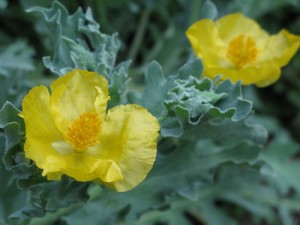Horned poppy (Glaucium flavum) flowering in Bonnefont Garden in a sunny bed devoted to medicinal plants. Like other members of the poppy family, the horned poppy contains poisonous alkaloids.
The yellow horned poppy hath whitish leaves very much cut or jagged, somewhat like the leaves of garden Poppie, but rougher and more hairie. The stalks be long, round, and brittle. The floures be large and yellow, consisting of foure leaves; which being past, there come long huskes or cods, crooked like an horn or cornet, wherein is conteined small black seede. The roote is great, thicke, scalie, and rough, continuing long.
???John Gerard (1545???1612)
The Elizabethan herbalist John Gerard???s meticulous description of the plant which he names in Latin as Papaver cornutum flore luteo, “the horned poppy with the yellow flower,” was based on personal observation. He notes that it “groweth upon the sands and banks of the sea,” and lists the many places along the English coast where he found it growing.
Renaissance botanists like Gerard were much occupied with identifying the plants they observed growing in their own locales with the plants named in the herbal of Dioscorides, and Gerard argues that the horned “sea poppy” might well be the glaucium of the ancient herbalist, despite the fact that Dioscorides had said that glaucium was to be found growing near the city of Heliopolis in Syria, and nowhere else.
Gerard may have been right about the likelihood of Glaucium flavum having a wide distribution. The plant has found its way to the United States and is listed as an invasive weed by the U.S.D.A. Yellow horned poppy has found a home not only on the east and west coasts, but also in Colorado and Oklahoma.
Whether or not the yellow horned poppy known to modern botanists as Glaucium flavum is the medicinal plant known to Dioscorides as glaucium, it was believed to be so in the Middle Ages. The fifteenth-century Hortus Sanitatis recommends glaucium as styptic and cooling, being especially good for erisypelas. As with other members of the poppy family, the toxic alkaloids present in yellow horned poppy are psychoactive. Geoffrey Grigson quotes a curious report made to the Royal Society in 1698, in which the experiences of a man who mistook the sea poppy for sea holly (Eryngium maritimum) are recorded. He baked the poisonous roots of the sea poppy in a pie, as was the custom with the edible roots of sea holly, and ate it hot from the oven. The cathartic and hallucinatory properties of Glaucium flavum acted on the unfortunate man’s system simultaneously. In his delirium, he mistook the contents of his chamber pot for gold.
???Deirdre Larkin
Sources:
Anderson, Frank J., ed. “Herbals through 1500,” The Illustrated Bartsch, Vol. 90. New York: Abaris, 1984.
Gerard, John. The Herbal, or General History of Plants. 1633 edition, revised and enlarged by Thomas Johnson. New York: Dover Press, 1975.
Grigson, Geoffrey. The Englishman’s Flora. 1955. Reprint: London: J.M. Dent & Sons, 1987.
Gunther, Robert T., ed. The Greek Herbal of Dioscorides, translated by John Goodyer 1655. 1934. Reprint: New York: Hafner Publishing, 1968.
Tags: alkaloid, Dioscorides, Eryngium maritimum, Geoffrey Grigson, Glaucium flavum, Hortus Sanitatis, John Gerard, poppy, sea holly, sea poppy


July 5, 2010 at 9:31 am
this is delightful…i so enjoy stopping in and reading about the medieval garden–